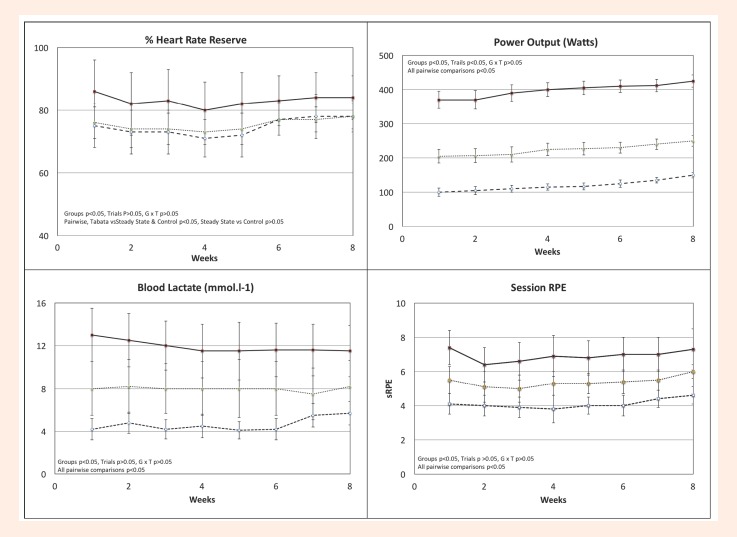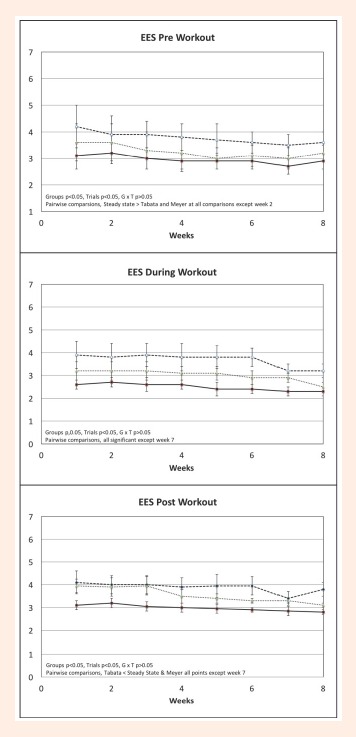Abstract
High intensity interval training (HIIT) has become an increasingly popular form of exercise due to its potentially large effects on exercise capacity and small time requirement. This study compared the effects of two HIIT protocols vs steady-state training on aerobic and anaerobic capacity following 8-weeks of training. Fifty-five untrained college-aged subjects were randomly assigned to three training groups (3x weekly). Steady-state (n = 19) exercised (cycle ergometer) 20 minutes at 90% of ventilatory threshold (VT). Tabata (n = 21) completed eight intervals of 20s at 170% VO2max/10s rest. Meyer (n = 15) completed 13 sets of 30s (20 min) @ 100% PVO2 max/ 60s recovery, average PO = 90% VT. Each subject did 24 training sessions during 8 weeks. Results: There were significant (p < 0.05) increases in VO2max (+19, +18 and +18%) and PPO (+17, +24 and +14%) for each training group, as well as significant increases in peak (+8, + 9 and +5%) & mean (+4, +7 and +6%) power during Wingate testing, but no significant differences between groups. Measures of the enjoyment of the training program indicated that the Tabata protocol was significantly less enjoyable (p < 0.05) than the steady state and Meyer protocols, and that the enjoyment of all protocols declined (p < 0.05) across the duration of the study. The results suggest that although HIIT protocols are time efficient, they are not superior to conventional exercise training in sedentary young adults.
Key points.
Steady state training equivalent to HIIT in untrained students
Mild interval training presents very similar physiologic challenge compared to steady state training
HIIT (particularly very high intensity variants were less enjoyable than steady state or mild interval training
Enjoyment of training decreases across the course of an 8 week experimental training program
Key words: training, Wingate, interval training, Tabata
Introduction
Interest in optimizing the magnitude of adaptation resulting from physical training, while minimizing the time and effort devoted to training, is a topic of considerable interest within the exercise community. Including classical studies of interval training for athletic performance (Astrand et al., 1960; Muller, 1953) the substantial body of evidence regarding the effects and side effects of variations in the Frequency, Intensity, Time and Type (FITT) of training are effectively codified in ACSM’s Guidelines for Exercise Testing and Prescription (Pescatello et al., 2014). This evidence is further addressed in the broad public health recommendation that healthy adults should accumulate 30 min of moderate intensity exercise on most if not all days of the week (Haskell et al., 2007), and that individuals interested in enhanced outcomes (including competitive performance) should regularly do both a larger volume of training and higher intensity training (Billat, 2001; Selier et al., 2013). Active research continues designed to determine how specific variations of FITT might further optimize adaptations to exercise training. The literature, particularly with reference to high intensity interval training (HIIT), has recently been reviewed (Buchiet and Laursen, 2013a; 2013b; Kessler et al. 2012; Weston et al., 2014). Since one of the chief barriers to broad public participation in exercise programs is a perceived lack of time (Salmon et al. 2003), one of the appeals of HIIT training has been that it potentially represents a more time efficient way to accomplish the adaptive goals of exercise training. Indeed, Gillen et al (2014) have shown that as little as three 10 min sessions weekly, with only 3 x 20s high intensity, could effect both muscle oxidative capacity and several markers of cardiometabolic health. Beyond the importance of time efficiency, there are a number of known motivations for participation in exercise programs (extrinsic motivators generally associated with changes in the body) and sport (intrinsic motivators related to pleasure and mastery) (Kilpatrick et al., 2002, 2005). These motivators can be contextualized within the concept of self-determination theory, which suggests that human activity can be understood within the context of seeking autonomy, competence and relatedness (Kilpatrick et al. 2002). Amongst the predictors of continuing an exercise program is recognition of the importance of enjoyment to long-term adherence with exercise programs (Dishman et al., 2005). There are relatively little data available regarding how different types of exercise programs are perceived by exercisers. Early evidence suggests that high-intensity interval running might be more enjoyable than moderate-intensity continuous exercise (Bartlett et al., 2011 Jung et al. 2014), although everyday experience suggests that higher intensity exercise is inherently less comfortable (i.e. enjoyable). This is important because even if exercise programs can be constructed in a very effective and time efficient format, if they are not perceived as enjoyable there is little likelihood that the program will be sustained for long enough to achieve reasonable health and fitness outcomes.
Beginning with studies demonstrating the value of interval training in clinical populations (Smodlaka, 1963; Meyer et al., 1990), and inspired by evidence that very high-intensity training can simultaneously produce adaptations in both aerobic and anaerobic exercise capacity (Tabata et al., 1996), interest in the potential value of HIIT, as an alternative to conventional training, has been considerable during the past 20 years. Studies from a number of laboratories, with protocols designed more to demonstrate the rapidity of molecular signaling events following high-intensity training (Babraj et al., 2009; Burgomaster et al., 2005; Gibala and McGee, 2008; Gibala et al., 2012; Helgerud et al., 2007, Whyte et al., 2010) than to have practical use (Bayati et al., 2011; Guiraud et al., 2010; Little et al., 2009; Matsuo et al., 2014; Nybo et al., 2010; Osawa et al., 2014; Rognmo et al., 2004) have demonstrated the ability of HIIT to produce large gains in both aerobic and anaerobic exercise ability, often with a remarkably reduced direct exercise time requirement. However, since these protocols have widely different levels of experimental control (sedentary vs aerobic exercise), there is still debate over the relative value of HIIT training relative to steady- state training. Further, since many of the HIIT protocols can present significant discomfort to the exerciser, the likelihood that long term adherence to HIIT training will be high enough to promote long term beneficial outcomes is of concern. However, we have little direct evidence about how different training programs are perceived. Accordingly, the purpose of this study was to compare physiologic responses of two basic HIIT variants against a steady-state training control in previously inactive young adults, as evidenced by changes in both aerobic and anaerobic exercise capacity. Additionally, we sought to evaluate how training was perceived in these groups, from the perspective of factors that might influence long term adherence.
Methods
Sixty-five (23 male, 42 female) relatively-sedentary subjects volunteered for the study. Their ages ranged from 18-28 years. The protocol, purpose, and risks of the study were explained to all interested participants. The Physical Activity Readiness Questionnaire (PAR-Q) was administered to the subjects prior to participation to rule out contraindications to participation. In order to be eligible for the study, subjects could not have been exercising more than twice per week at low-to-moderate intensity during the preceding three months (e.g. < 2 hr per week). Qualified subjects provided written informed consent before participating. The study was approved by the University Institutional Review Board for the Protection of Human Subjects, and conformed to the principles outlined in the Declaration of Helsinki.
An incremental exercise test, performed on an electrically braked cycle ergometer (Lode Excalibur, Groningen, NL), was used to assess aerobic capacity. The subjects were instructed to abstain from caffeine for 6 hours before the test, which was conducted (within subject) in a period of ±2 hours of each day. A practice test was not administered. The test began with a 5-min resting period to allow measurement of resting HR, followed by a 3-minute warm up at 25 W. After 3 minutes, the load was increased by 25 W per minute. Subjects pedaled at a cadence ~80 rpm. The test was terminated when subjects were too fatigued to continue, or when the cadence fell below 60 rpm. Maximal HR was measured using radiotelemetry (Polar Electro-Oy, Kempele, Finland). The Rating of Perceived Exertion (RPE) was measured during the test using the Category Ratio (0-10) RPE scale (Borg, 1998). Respiratory metabolism was measured using open-circuit spirometry, with a mixing chamber based metabolic cart (Parvo Medics, Sandy, Utah). Calibration was completed before each test using a reference gas (16% O2 & 4% CO2) and room air. A 3-L syringe was used to calibrate the pneumotach. VO2 was summated every 30s, and the highest 30s value during the test was accepted as VO2max. A verification trial was not performed as we have previously found that there is no systematic change in VO2max during a second exercise effort at higher muscular power output (Foster et al., 2007). The peak aerobic power, expressed per kg BW (PaerPO) was accepted as the PO for the highest stage completed plus proportional credit for incomplete stages.
As a measure of anaerobic power-capacity, the subjects performed the Wingate Anaerobic Test (Bar-Or, 1987). The test was performed, on a different day, on an electronically braked cycle ergometer (Lode Excalibur, Groningen, NL), in the constant torque mode. The subjects warmed up for 5-min at 25W. In the last 5-s of the warm-up period, the subject increased their pedaling rate to >100 rpm (with no resistance on the flywheel). At the beginning of the test the resistance was increased to 0.075 kg.kg-1 BW and the subject attempted to maximize their pedaling rate for the next 30s. Peak power output (PPO) (the highest PO observed during 1s during the test) and the mean power output (MPO)(the average PO over the 30s duration of the test) were recorded from the ergometer software. The PPO and MPO were expressed relative to BW. As an additional marker of exercise capacity, the Combined Exercise Capacity (CEC) was calculated as the mean of PaerPO + PPO + MPO, and expressed as W.kg-1 BW.
One day during each week of the 8-week training program the subjects completed the Exercise Enjoyment Scale (EES) (Stanley et al., 2010). The ESS was administered pre-, during- and post-training to determine the subject’s perceived level of enjoyment. A rank of zero indicated the absence of enjoyment, while a rank of seven indicated high enjoyment. All subjects were directed to rank their perceived level of enjoyment at the exact moment in time that the scale was administered. Within subjects, the ESS was admininstered on the same day of each week. For logistic reasons, between subjects the administration of the ESS was distributed throughout the week.
Training
Following pre-testing, the subject’s exercise capacity was ranked based on the CEC. Males and females were ranked separately. From these rankings, subjects were stratified into groups (best 3, next three, …..worst three) and from these groups were randomly assigned to the three training groups: steady-state, very brief, very high intensity interval training (Tabata et al.. 1996), or moderate intensity interval training (Meyer et al., 1990). Training was performed on mechanically braked ergometers (Monarch GBH, Varburg, Sweden) with the pedaling rate controlled by a metronome. All training sessions were supervised 1 to 1 by laboratory assistants.
Identical five-minute warm-up and cool-down periods were performed by all three training groups (2 min at 25 W, 1 min at 50 W, 1 min at 75 W, 1 min at 25 W). Steady-state training consisted of 20-min of continuous exercise at a PO calculated to require a VO2 of 90% of ventillatory threshold (VT) (Foster and Cotter, 2005), based on the pre-training VO2max test, and to fit into the moderate to vigorous intensity as defined by ACSM (Pescatello et al. 2013). Meyer interval training consisted of 20 minutes (13 sets) of 30s work intervals (at 100% PaerPO from the pre-training VO2max test) paired with 60S of active recovery (at a PO calculated to yield a mean PO @ 90% VT). Tabata training consisted of 20s of work at a PO calculated to require 170% of Paer paired with 10s of unloaded pedaling for a total of 8 sets, or 4 min. Steady-state and Meyer subjects cycled at a cadence of 80 rpm, while Tabata subjects pedaled at 90 rpm during the loaded period.
At the end of each day of training the session RPE (sRPE) was assessed (Foster et al., 1995). When sRPE decreased by 2 units or greater, the PO was increased ~ 10% for the next training session. In the two HIIT groups, PO was increased in the loaded segment by increasing flywheel torque; recovery PO remained constant. All subjects completed 24 exercise sessions over the 8-week training period. To further document the training intensity, HR and [blood lactate] (Lactate Pro) were measured during one training session each week. However, decisions regarding progression of the training load were based solely on sRPE.
Statistical analysis
Standard descriptive statistics were used to characterize the subject population. A one-way analysis of variance (ANOVA) was performed across pre-training scores to determine if the groups were similar at the beginning of the study. A three-way ANOVA with repeated measures was then performed (pre/post x group x gender) to determine if there were any between group changes as a result of training. When there was a significant F-ratio, Tukey’s post-hoc tests were used to determine pairwise differences. Alpha was set at .05 to achieve statistical significance. Analysis was performed on data from the subjects who completed the entire protocol.
Results
Fifty-five of the original 65 subjects completed the study (17 male, 38 female). Descriptive characteristics of the subjects are presented in Table 1. The steady-state group lost one male due to loss of interest (unwillingness to continue the protocol). The Tabata group lost three female subjects, two due to loss of interest and one other to an unrelated injury. The Meyer group lost a total of six subjects. One female was lost due to loss of interest, four males due to unrelated injury/illness, and one female due to unrelated injury. No significant differences existed between the three training groups with regards to age, height, and weight at the start of the study.
Table 1.
Descriptive characteristics of the subjects who completed the study. Data are means (±SD).
| Steady-State (n=19) |
Tabata (n=21) |
Meyer (n=15) |
|
|---|---|---|---|
| Age (yrs) | |||
| Males | 19.5 (1.4) | 20.3 (2.1) | 19.3 (1.3) |
| Females | 19.6 (2.9) | 19.5 (1.2) | 19.9 (2.8) |
| Height (m) | |||
| Males | 1.82 (.09) | 1.75 (.06) | 1.79 (.11) |
| Females | 1.65 (.05) | 169 (.04) | 1.65 (.05) |
| Weight (kg) | |||
| Males | 94.3 (7.2) | 81.0 (13.9) | 76.4 (12.5) |
| Females | 68.6 (15.1) | 68.2 (14.0) | 71.9 (18.6) |
The acute responses during the training program are presented in Figure 1. There was a progressive increase in training PO in all groups, amounting to 50 W in the steady state group (+50%), 45 W in the PO of the hard segment of the Meyer group (+45%), and 70 W in the PO of the hard segment in the Tabata group (+18%). Despite these progressions of the external training load training, markers of the internal training load (%HRR, sRPE, blood lactate) remained constant during the 8-week training period (Figure 1). The HR at the end of the training bout was 75-80% HRR in the steady-state and Meyer groups, whereas in the Tabata group the HR approximated 85% HRR. Blood lactate concentration at the end of the training bouts was 5-6 mmol.l-1 in the steady-state group, ~8 mmol.l-1 in the Meyer group, and ~12 mmol.l-1 in the Tabata group. The sRPE was 4-5 (somewhat hard to hard), 5-6 (hard+) and 7-8 (very hard) in the steady-state, Meyer and Tabata groups, respectively.
Figure 1.

Acute responses (mean ±sd) during training in the three experimental groups (circles=steady state, triangles=Meyer, Squares=Tabata) across the training program. Power output in the HIIT groups is expressed as Watts during the loaded segments.
There were no significant differences between groups for any variable pre-training. There were no significant differences in responses of males vs. females over the course of the study, thus training group data were collapsed across gender.
VO2max changed significantly in all three groups (Table 2). This represented ~18% increase across training, with no differences between training groups. When the data were expressed as body weight normalized power output, there were significant changes across training in all groups, with no differences between groups. When the body weight normalized power output was expressed as the combined exercise capacity (CEC), there was a 6-10% increase with training, but no difference between groups (Table 2).
Table 2.
Changes in VO2max, PaerPO, Wingate PPO and Wingate MPO in the three training groups. All groups improved significantly, but there was no evidencce that one group improved significantly more than the others. Data are means (±SD).
| Measure | Pre Training | Post Training | Change (%) | |
|---|---|---|---|---|
| VO2max (ml.kg-1) | Steady-State | 33.6 (5.4) | 40.1 (6.3) | 19% * |
| Tabata | 34.0 (6.5) | 40.1 (6.8) | 18% * | |
| Meyer | 34.3 (9.1) | 40.6 (8.7) | 18% * | |
| PaerPO (W.kg-1) | Steady-State | 2.65 (.61) | 3.09 (.76) | 17% * |
| Tabata | 2.72 (.77) | 3.36 (.69) | 24% * | |
| Meyer | 2.81 (.70) | 3.21 (.69) | 14% * | |
| Wingate PPO (W.kg-1) | Steady-State | 11.5 (1.6) | 12.4 (1.4) | 8% * |
| Tabata | 11.7 (1.4) | 12.7 (1.4) | 9% * | |
| Meyer | 11.8 (1.5) | 12.4 (1.7) | 5% * | |
| Wingate MPO (W.kg-1) | Steady-State | 6.1 (1.0) | 6.3 (.9) | 4% * |
| Tabata | 6.4 (1.0) | 6.9 (1.1) | 7% * | |
| Meyer | 6.2 (1.3) | 6.6 (1.0) | 6% * | |
| Combined Exercise | Steady-State | 6.75 (1.07) | 7.26 (1.02) | 7.6% * |
| Capacity (W.kg-1) | Tabata | 6.94 (1.06) | 7.65 (1.06) | 10.2% * |
| Meyer | 6.94 (1.17) | 7.40 (1.13) | 6.6% * | |
* p < 0.05
The EES demonstrated a significantly declining score across weeks in all groups, with significantly lower values in the Tabata group. There was not a significant weeks x group interaction effect (Figure 2). The EES was lower during training than either before or after training.
Figure 2.

Changes in the acute Exercise Enjoyment Score (possible score 1-7) (mean ±sd) measured prior to (top), during (middle) and after (bottom) training bouts (all measurements on the same day within subjects) in relation to the type of training and the duration of the study (circles=steady state, triangles=Meyer, Squares=Tabata). Notably, the ESS is generally declining across the course of the study, and the most intense training scheme (Tablata) was rated the least enjoyable.
Discussion
The main finding of this study was the substantial equivalence of increases in measures of both aerobic and anaerobic exercise performance in all three training groups. Contrary to the frequent claims in the literature of larger responses following high- intensity exercise training regimes, in this group of relatively untrained young adults there was no apparent advantage gained from more intense exercise. Even considering the numerically greater increase in all measures of exercise capacity in the Tabata group, there was not a significantly larger increase in the CEC in any of the groups.
The second major finding was that the EES declined progressively across the duration of the study. Additionally, the EES was lower during the most intense (Tabata et al. 1996) training scheme. Put simply, the subjects were significantly less likely to enjoy the most intense training protocol, and their enjoyment of all the protocols declined over time.
The magnitude of improvement in measures of aerobic exercise performance (VO2max and Paer) is consistent with other short-term training studies in relatively untrained trained young adults (Bouchard et al., 1999; Helgerud et al., 2007; Matsuo et al., 2014; Nybo et al., 2010; Pollock, 1973; Rognmo et al., 2004; Tabata et al., 1996). In studies with an appropriate steady-state control group, interval training has usually produced a larger increase in VO2max than nominally similar steady state-training. Indeed, studies like that of Gillen et al. (2010) suggest that even very brief high intensity training protocols can produce stubstantial increases in markers of cardiometabolic health. Certainly in already well-trained individuals, interval training seems to be necessary to provoke additional increases in exercise capacity that cannot be achieved with steady-state training (Laursen, 2010; Gorostiaga et al., 1991; Seiler et al., 2013; Stepto et al., 1999). Remarkably, in the present data was the comparatively large increase in the magnitude of improvement in the steady-state group. Ignoring the report of Meyer et al. (1990), which represents early post-bypass surgery patients (with a very large margin for improving), other studies have observed ~15% increases in VO2max per kg BW in HIIT groups over 6-12 weeks of training, compared to ~10% in control groups performing steady-state training. In the current results the increase in VO2max per kg BW was 18-20%. These results do not appear to be attributable to uniquely high values for training intensity in the control group, which averaged 75-80% HRR (e.g. moderate to vigorous training intensity) and an sRPE of 4-5 on the Category Ratio RPE scale, although [blood lactate] averaged 4-6 mmol·l-1 which suggests training intensity was in the vigorous if not severe training classification
One of the most remarkable (but perhaps not surprising) findings of this study is the significantly lower level of enjoyment in the Tabata group, and the progressively declining level of enjoyment in all groups across the course of the study. Several studies (Bartlett et al. 2011, Jung et al. 2014, Kilpartirck et al., 2012) all suggest that moderate intensity interval training may be more pleasant than moderate intensity continuous exercise. However, Tabata type protocols (very high intensity intervals with very short recovery periods) are so physically chanllenging that they are very unlikely to be perceived as pleasant. Regardless of how effective an exercise training program might be, adherence over any meaningful period of time is unlikely in programs that are not enjoyable. Regardless of whether the EES was obtained before, during or after training, the very high intensity Tabata protocol was rated as the least enjoyable. Despite the contemporary popularity of Tabata type training within the fitness industry, it must be remembered that the development of this type of training was based on extrapolating training practices of highly motivated strength-power athletes (speed skaters) to the general exercising public. To expect non-athletes to find this type of training enjoyable is probably unreasonable. In this context, it is worth noting that several studies which have been based on very short-term (2 weeks) models of repetitive Wingate tests (which are widely known to be unpleasant), were designed to demonstrate the rapidity of the skeletal muscle and metabolic adaptive response to high levels of molecular signaling. It seems reasonable to suggest that the findings of these high intensity studies have been extrapolated by the fitness community into daily practice, without the benefit of longer term studies supporting short term experimental results. From what we know of the intra muscular molecular responses to HIIT (Burgomaster et al., 2005, Gibala and McGee, 2008, Gibala et al., 2012) it would be reasonable to suggest that protocols less demanding (and likely less unpleasant) than the Burgomater model of repeat Wingate tests or the Tabata model of ultra-high intensity exercise with very short recovery periods, might induce (in previously untrained people) many of the same skeletal muscle and metabolic adaptations, in a way that is more likely to be enjoyable enough to be continued for long periods of time. This is supported by the somewhat briefer, and less demanding, protocol recommended by Gillen et al. (2010). However, the comparability of MRNA expression following iso-energetic continuous and interval training (Wang et al. 2009) argues that in untrained people, the responsiveness of the muscle to training may be so high that the details of how training is accomplished may be comparatively less important.
Another element of high-intensity training that has been widely promoted is the supposed time efficiency of HIIT protocols. In the current data, substantially equivalent results were realized by the Tabata protocol in 14 min (warm-up + training + cool-down) versus 30 min in the steady-state and Meyer protocols. Considering only this time commitment the Tabata protocol is, indeed, more time efficient than the more conventional training models. More strikingly, Gillen et al. (2014) have shown that as little as three 10 min sessions per week, with only 3 x 20s at high intensity, could have significant effects on muscle oxidative capacity and several markers of cardiometabolic health. Similarly, Hazell et al (2010) have shown that high intensity bouts as short as 10s (which is much less onerous than the 30s bouts typical of repeated Wingate tests) could induce substantial changes in VO2max. However, the experience during the study was that both the steady-state and Meyer subjects were fully recovered and ready to ‘return to normal life’ immediately following the conclusion of the cool-down period. On the other hand, subjects in the Tabata protocol were still visibly distressed at the end of the cool-down period and often required an extended period of time to recover to the point where they could again pursue normal activities. Viewed from the perspective that the time efficiency of training must be evaluated based on the preparation + training + recovery time, the Tabata protocol (which we take as broadly representative of the currently popular HIIT training models) cannot be considered to be particularly time efficient. Nevertheless, in a comparison of sprint interval and high intensity interval training, broadly comparable to the Tabata and Meyer protocols in the present study, Wood et al. (2015) demonstrated that essentially half of participants preferred the more ‘sprint’ type training. And, it must be acknowledged that the results of Gillen et al. (2010) with very brief training bouts are supportive of the potential of HIIT, certainly considering that exercise modes that recruit relatively more muscle fibers (including relatively more Type II motor units) may have unique cardiometabolic effects that deserve further investigation.
The logic behind HIIT training models is that they may produce a large adaptive response by virtue of recruiting a broader population of muscle fibers (Gollnick et al., 1974) and by providing a larger cardiorespiratory signal to adapt (Buchheit and Laursen, 2013a; 2013b). To the degree that there have been large changes demonstrated in elements of muscle physiology including markers of molecular signaling (Gibala et al., 2008, 2012) with high intensity training, this logic seems valid. Higher intensity training is clearly advantageous for more athletic individuals who have a smaller adaptive response window (Billat, 2001; Gunnarsson and Bangsbo, 2012; Seiler et al., 2013; Stepto et al., 1999, Tschakert and Hofmann, 2013). However, the present results suggest, in the setting of a practical exercise training protocol, that there is little unique advantage to HIIT protocols with minimally trained individuals. Further, given that the enjoyment of the highest intensity protocol was lower, it seems reasonable to suggest that long-term adherence to this form of training may be unfavorable. The generally declining EES in all three groups suggests that the novelty in the structure of a training program may be rather the more important issue. Although we are unaware of evidence regarding how the structure of training programs influences the EES, or for that matter how the EES influences the long-term adherence to exercise programs, it seems reasonable to suggest that variation in the structure of exercise programs might be important to long term adherence, just as periodization of the physical stresses of an exercise program is important to the physiological responses to training.
A limitation of the study in terms of subject selection needs to be acknowledged. Recruiting truly sedentary subjects, who are not generally interested in exercise of any form, for a study that includes the possibility of being randomized to a quite vigorous training program is difficult. On the other hand, in a university community, even nominally sedentary subjects may have background levels of activity that are higher than ideal. We only accepted ~33% of subjects expressing an interest in the study. Most of those who were rejected were either too active currently, or had a recent history of sports participation (usually in high school).
Exercise training protocols also have to be evaluated in terms of safety. Although exercise training is generally quite safe (Foster and Porcari, 2008), higher intensity exercise has been shown to be a trigger for acute myocardial infarction in middle-aged and older individuals (Franklin and Billecke, 2012) and there has been recent concern that “excessive” volume and intensity of exercise training, in athletic individuals, may lead to adverse cardiac remodeling (O’Keefe et al., 2015). Within this context, it seems reasonable to suggest that HIIT protocols should be used somewhat sparingly.
Conclusion
In conclusion, in this population of relatively untrained but healthy young adults, our results suggest no particular advantage for very high intensity training models, such as that which has been widely adapted from the results of Tabata et al. (1996). The observation that the Tabata protocol was less enjoyable is not surprising. The progressive loss of enjoyment across all the protocols suggests that perhaps variety in the type of exercise is as important as the type of exercise per se. Particularly considering that the health benefits of exercise have to be viewed in the context of the likelihood that exercise is continued for several years, not just the weeks of a controlled study. Perhaps, in our quest to find the ‘perfect exercise’ we have missed the more important issue of how to make exercise enjoyable enough to be continued long term.
Acknowledgements
This study was performed in compliance with the laws of the United States of America. This study was supported by a grant to John Porcari, Ph.D. from the American Council on Exericse.
Biographies

Carl FOSTER
Employment
Professor of Exercise and Sport Science, University of Wiscosnsin-La Crosse
Degree
Ph.D.
Research interests
Exercise physiololgy
E-mail: cfoster@uwlax.edu

Courtney V. FARLAND
Employment
Graduate student, University of Wisconsin-La Crosse
Degree
M.S.
Research interests
Clinical Exercise Physiology

Flavia GUIDOTTI
Employment
Department of human movement science, University of Rome, Foro Italico
Degree
Ph.D.
Research interests
Exercise science

Michelle HARBIN
Employment
Graduate student, exercise science, University of Minnesota
Degree
M.S.
Research interests
Exercise physiology

Brianna ROBERTS
Employment
Graduate student, University of Wisconsin-La Crosse
Degree
M.S.
Research interests
Clinical Exercise Physiology

Jeff SCHUETTE
Employment
Graduate student, University of Wisconsin-La Crosse
Degree
M.S.
Research interests
Clinical Exercise Physiology

Andrew TUURI
Employment
Graduate Student, University of Wisconsin-La Crosse
Degree
M.S.
Research interests
Clinical Exercise Physiology

Scott T. DOBERSTEIN
Employment
Senior academic staff—exercise and sport science, University of Wisconsin-La Crosse
Degree
M.S., ATC
Research interests
Athletic training

John P. PORCARI
Employment
Professor of Exercise and Sport Science, University of Wisconsin-La Crosse
Degree
Ph.D.
Research interests
Exercise Physiology
References
- Astrand I., Astrand P.O., Christensen E.H., Hedman R. (1960) Intermittent muscular work. Acta Physiologicia Scandinavia 48, 448-453. [DOI] [PubMed] [Google Scholar]
- Babraj J.A., Vollaard N.B.J., Keast C., Guppy F.M., Cottrell G., Timmons J.A. (2009) Extremely short duration high-intensity interval training substantially improves insulin action in young healthy males. BMC Endocrine Disorders 9, 1-8. [DOI] [PMC free article] [PubMed] [Google Scholar]
- Bar-Or O. (1987) The Wingate Anaerobic Test: An update on methodology, validity and reliability. Sports Medicine 4, 381-394. [DOI] [PubMed] [Google Scholar]
- Bartlett J.O., Close G.L., Maclaren D.P.M., Gregson W., Drust B., Morton J.P. (2011) High-intensity interval running is perceived to be more enjoyable than moderate-intensity continuous exercise: implications for exercise prescription. Journal of Sports Sciences 29, 547-553. [DOI] [PubMed] [Google Scholar]
- Bayati M., Farzad B., Gharakhanlou R., Agha-alinejad H. (2011) A practical model of low-volume high-intensity interval training induces performance and metabolic adaptatins that resemble ‘all-out’ sprint interval training. Journal of Sport Science and Medicine 10, 571-576. [PMC free article] [PubMed] [Google Scholar]
- Billat V.L. (2001) Interval training for performance: a scientific and empirical practice: special recommendations for middle- and long-distance running. Part I: aerobic interval training. Sports Medicine 1, 13-31. [DOI] [PubMed] [Google Scholar]
- Borg G. (1998) Borg’s Perceived Exertion and Pain Scales. Champaign, Il, Human Kinetics Press. [Google Scholar]
- Bouchard C., Rice T., Skinner J.S., Wilmore J.H., Gagnon J., Perusse L., Leon A., Rao D.C. (1999) Familial aggregation of VO2max response to exercise training: results from the HERITAGE Famly study. Journal of Applied Physiology 87, 1003-1008. [DOI] [PubMed] [Google Scholar]
- Buchheit M., Laursen P.B. (2013a) High-intensity training, solutions to the programming puzzle. Part I: cardiopulmonary emphasis. Sports Medicine 43, 313-338. [DOI] [PubMed] [Google Scholar]
- Buchheit M., Laursen P.B. (2013b) High-intensity interval training, solutions to the programming puzzle. Part II: anaerobic energy, neuromuscular load and practical applications. Sports Medicine 43, 927-954. [DOI] [PubMed] [Google Scholar]
- Burgomater K.A., Hughes S.C., Heigenhauser G.J.F., Bradwell S.N., Gibala M.J. (2005). Six sessions of sprint interval training increases muscle oxidative potential and cycle endurance capacity in humans. Journal of Applied Physiology 98, 1985-1900. [DOI] [PubMed] [Google Scholar]
- Dishman R.K., Motl R.W., Saunders R., Felton G., Ward D.S., Dowda M., Pate R.R. (2005) Enjoyment mediates effects of a school-based physical activity intervention. Medicine and Science in Sports and Exercise 37(3), 478-487. [DOI] [PubMed] [Google Scholar]
- Foster C., Hector L.L., Welsh R., Schrager M., Green M.A., Snyder A.C. (1995) Effects of specific vs cross training on running performance. European Journal of Applied Physiology 70, 367-372. [DOI] [PubMed] [Google Scholar]
- Foster C., Cotter H.M. (2005) Blood lactate, respiratory and heart rate markers on the capacity for sustained exercise. In: Physiological Assessment of Human Fitness. : Maud P.J., Foster C. 2nd edition Champaign, Il, Human Kinetics Press; pp 63-76. [Google Scholar]
- Foster C., Kuffel E., Bradley N., Battista R.A., Wright G., Porcari J.P., Lucia A., de Koning J.J. (2007) VO2max during successive maximal efforts. European Journal of Applied Physiology 102, 67-72. [DOI] [PubMed] [Google Scholar]
- Foster C., Porcari J.P., Battista R.A, Udermann B., Wright G., Lucia A. (2008) The risk of exercise training. American Journal of Lifestyle Medicine 2, 279-208. [Google Scholar]
- Franklin B.A., Billecke S. (2012) Putting the benefits and risks of aerobic exercise in perspective. Current Sports Medicine Reports 11, 201-208. [DOI] [PubMed] [Google Scholar]
- Gibala M.J., McGee S.L. (2008) Metabolic adaptations to short-term high-intensity interval training: A little pain for a lot of gain. Exercise and Sport Sciences Reviews 36, 58-63. [DOI] [PubMed] [Google Scholar]
- Gibala M.J., Little J.P., MacDonald M.J., Hawley J.A. (2012) Physiological adaptations to low-volume, high-intensity interval training in health and disease. Journal of Physiology 590, 1077-1084. [DOI] [PMC free article] [PubMed] [Google Scholar]
- Gilllen J.B., Percival M.E., Skelly S.E., Martin B.J., Tan R.B., Tarnopolsky M.A., Gibala M.J. (2010) Three minutes of all-out intermittent exercise per week increases skeletal muscle oxidative capacity and improves cardiometabolic health. PLoS ONE 9, e111489. [DOI] [PMC free article] [PubMed] [Google Scholar]
- Gollnick P.D., Piehl K., Saltin B. (1974) Selective glycogen depletion pattern in human muscle fibers after exercise of varying intensity and at varying pedaling rates. Journal of Physiology 241, 45-57. [DOI] [PMC free article] [PubMed] [Google Scholar]
- Gorostiaga E.M., Walter C.B., Foster C., Hickson R.C. (1991) Uniqueness of interval and continuous training at the same maintained exercise intensity. European Journal of Applied Physiology 63, 101-107. [DOI] [PubMed] [Google Scholar]
- Guiraud T., Jeneau M., Nigam A., Gayda M., Meyer P., Mckary S., Pillard F., Bosquet L. (2010) Optimizatin of high intensity interval exercise in coronary heart disease. European Journal of Applied Physiology 108, 733-740. [DOI] [PubMed] [Google Scholar]
- Gunnarsson T.P., Bangsbo J. (2012) The 10-20-30 training concept improves performance and health profile in moderately trained runners. Journal of Applied Physiology 113, 16-24. [DOI] [PubMed] [Google Scholar]
- Haskell W.L., Lee I-M, Pate R., Powell K.E., Blair S.N., Franklin B.A., Macera C.A., Heath G.W., Thompson P.D., Bauman A. (2007) Physical activity and public health recommendation for adults from the American College of Sports Medicine and the American Heart Association. Medicine and Science in Sports and Exercise 39, 1423-1434. [DOI] [PubMed] [Google Scholar]
- Hazell T.J., MacPherson R.E.K., Gravelle B.M.R., Llemon P.W.R. (2010). 10 or 30-s sprint interval training bouts enhance both aerobic and anerobic performance. European Journal of Applied Physiology 110, 153-160. [DOI] [PubMed] [Google Scholar]
- Helgerud J., Hoydal K., Wang E., Karlsen T., Berg P., Bjerkaas M., simonsen T., Helgesen C., Hjorth N., Bach R., Hoff J. (2007) Aerobic high-intensity intervals improve VO2max more than moderate training. Medicine and Science in Sports and Exercise 39, 665-671. [DOI] [PubMed] [Google Scholar]
- Jung M.E., Bourne J.E., Little J.P. (2014) Where does HIT fit? An examination of the affective response to high-intensity intervals in comparison to continuous moderate and continuous vigorous intensity exercise in the exercise intensity-affect continuum. PLoS ONE 9, e114541. [DOI] [PMC free article] [PubMed] [Google Scholar]
- Kessler H.S., Sisson S.B., Short K.R. (2012) The potential for high-intensity interval training to reduce cardiometabolic disease risk. Sports Medicine 42, 489-509. [DOI] [PubMed] [Google Scholar]
- Kilpatrick M., Hebert E., Jocobsen D. (2002) Physical activity motivation: A practitioners guide to self-determination theory. Journal of Physical Education, Recreation and Dance 73, 36-41. [Google Scholar]
- Kilpatrick M., Hebert E., Bartholomew J. (2005) College students’ motivation for physical activity: differentiating men’s and women’s motives for sport participation and exercise. Journal of American College Health 54, 87-94. [DOI] [PubMed] [Google Scholar]
- Laursen B.B. (2010). Training for intense exercise performance: high intensity or high volume training? Scandinavian Journal of Medicine and Science in Sports 20, (Suppl 2) 1-10. [DOI] [PubMed] [Google Scholar]
- Little J.P., Safdar A., Wilkin G.P., Tarnopolsky M.A., Gibala M.J. (2010) A practical model of low-volume high-intensity interval training induces mitochondrial biogenesis in human skeletal muscle: potential mechanisms. Journal of Physiology 588, 1011-1022. [DOI] [PMC free article] [PubMed] [Google Scholar]
- Matsuo T., Saotome K., Seino S., Eto M., Shimojo N., Matsushita A., Iemitsu M., Oshima H., Tanaka K., Mukai C. (2014) Low-volume, high intensity aerobic interval exercise for sedentary adults: VO2max, cardiac mass and heart rate recovery. European Journal of Applied Physiology 114, 1963-1972. [DOI] [PubMed] [Google Scholar]
- Meyer K., Lehmann M., sunder G., Keul J., Weidemann (1990) Interval versus continuous exercise training after coronary bypass surgery: A comparison of training-induced acute reactions with respect to the effectiveness of the exercise methods. Clinical Cardiology 13, 851-861. [DOI] [PubMed] [Google Scholar]
- Muller E.A. (1953) The physiological basis of rest pauses in heavy work. Quarterly Journal of Experimental Physiology Congress of Medical Science 38, 205-215. [DOI] [PubMed] [Google Scholar]
- Nybo L., Sundstrup E., Jokobsen M.D., Mohr M., Hornsturp T., Simonsen L., Bulow J., Randers M.B., Nielsen J.J., Aagaard P. (2010) High-intensity training versus traditional exercise interventions for promotion health. Medicine and Science in Sports and Exercise 42, 1951-1958. [DOI] [PubMed] [Google Scholar]
- O’Keefe J.H., Lavie C.J., Guazzi M. (2015) Potential dangers of extreme endurance exercise: How much is too much? Progress in Cardiovascular Diseases 57, 396-405. [DOI] [PubMed] [Google Scholar]
- Osawa Y., Azuma K., Tabata S., Katsukawa F., Ishida H., Oguma Y., Kawai T., Itoh H., Okuda S., Matsumoto H. (2014) Effects of a 16-week high-intensity interval training using upper and lower body ergometers on aerobic fitness and morphological changes in healthy men: a preliminary study. Open Access Journal of Sorts Medicine 4, 257-265. [DOI] [PMC free article] [PubMed] [Google Scholar]
- Pescatello L.S., Arena R., Riebe D., Thompson P.S. (2013) ACSM’s Guidelines for Exercise Testing and Prescription. 9th edition Philadelphia, Lippincott, Williams & Wilkins. [DOI] [PubMed] [Google Scholar]
- Pollock M.L. (1973) The quantification of endurance training programs. Exercise and Sport Sciences Reviews 1, 155-188. [PubMed] [Google Scholar]
- Rognmo O., Hetland E., Helgerud J., Hoff J., Slordahl S.A. (2004) High intensity aerobic interval exercise is superior to moderate intensity exercise for increasing aerobic capacity in patients with coronary artery disease. European Journal of Cardiovascular Prevention and Rehabilitation 11, 216-222. [DOI] [PubMed] [Google Scholar]
- Salmon J., Owen N., Crawford D., Bauman A., Sallis J.F. (2003) Physical activity and sedentary behavior: A population-based study of barriers, enjoyment and preference. Health Psychology 22, 178-188. [DOI] [PubMed] [Google Scholar]
- Seiler S., Joranson K., Olesen B.V., Hetlelid K.J. (2013) Adaptations to aerobic interval training: interactive effects of exercise intensity and total work duration. Scandinavian Journal of Medicine and Science in Sports 23, 74-83. [DOI] [PubMed] [Google Scholar]
- Smodlaka V. (1963) Interval training in heart disease. Journal of Sports Medicine 3, 93-96. [PubMed] [Google Scholar]
- Stanley D.M., Willaims S.E., Cumming J. (2010) Are we having fun yet? Testing the effects of imagery use on the affective and enjoyment responses to acute moderate exercise. Psychology of Sport and Exercise 11, 582-590. [Google Scholar]
- Stepto N.K., Hawley J.A., Dennis S.C., Hopkins W.G. (1999) Effects of different interval-training programs on cycling time-trial performance. Medicine and Science in Sports and Exercise 31, 736-741. [DOI] [PubMed] [Google Scholar]
- Tabata I., Nishimura K., Kouzaki M., Hiral Y., Ogita F., Miyachi M., Yamamoto K. (1996) Effects of moderate-intensity endurance and high-intensity intermittent training on anaerobic capacity and VO2max. Medicine and Science in Sports and Exercise 28, 1327-1330. [DOI] [PubMed] [Google Scholar]
- Tschakert G., Kroepfl J., Mueller A., Moser O., Groeschl W., Hofmann P. (2015) How to regulate the acute physiological response to “aerobic” high interval exercise. Journal of Sports Science and Medicine 14, 29-36. [PMC free article] [PubMed] [Google Scholar]
- Wang L., Psilander N., Tonkonogi M., Ding S., Sahlin K. (2009) Similar expression of oxidative genes after interval and continuous exercise. Medicine and Science in Sports and Exercise 41, 2136-2144. [DOI] [PubMed] [Google Scholar]
- Weston M., Taylor K.L., Batterham A.M., Hopkins W.G. (2014) Effects of low-volume, high intensity interval training (HIT) on fitness in adults: A meta-analysis of controlled and non-controlled trials. Sports Medicine 44, 1005-1017. [DOI] [PMC free article] [PubMed] [Google Scholar]
- Wood K.M., Olive B., La Valle K., Thompson H., Green K., Astorino T.A. (2015) Dissimilar physiological and perceptual responses between spirnt interval training and high intensity interval training. Journal of Strength and Conditioning Research (In press). [DOI] [PubMed] [Google Scholar]
- Whyte L.J., Gill J.M.R., Cathcart A.J. (2010) Effect of 2 weeks of sprint interval training on health-related outcomes in sedentary overweight/obese men. Metabolism Exerimental and Clinical 59, 1421-1428. [DOI] [PubMed] [Google Scholar]


